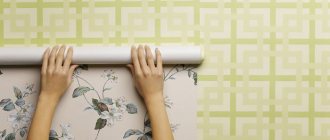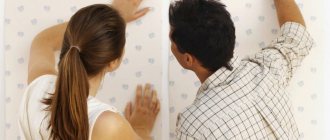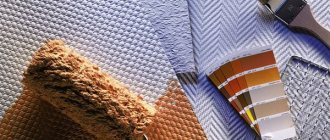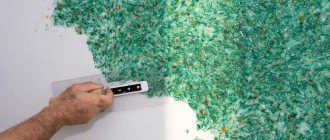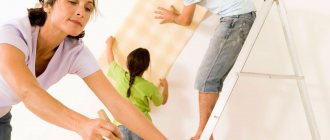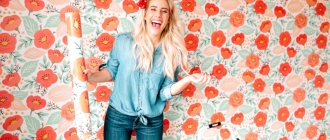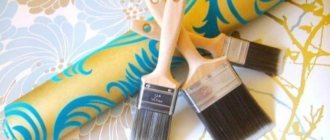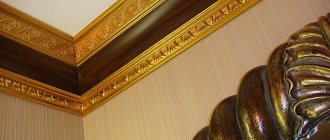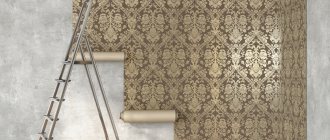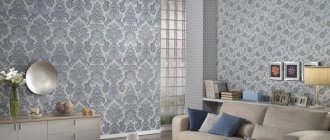Every person may have a moment when he suddenly realizes that he is tired of what he sees around him every day. But this understanding does not always entail a readiness to radically change the interior and completely remodel the apartment. Then a successful design solution comes to the rescue - replacing the usual wallpaper with photo wallpaper. And if during the first finishing of a new building apartment there is no doubt about the need for rough preparation of the walls, then during subsequent cosmetic repairs the volume, cost and dustiness of the work cause justified panic. There may also be a need to cover not the entire wall with photo wallpaper, but only a section of it (as an option - a photo panel). In these cases, a logical question arises: is it possible to glue photo wallpaper onto old wallpaper? The answer to this can only be positive if strict conditions are met.
Important! Despite the fact that the new canvases are planned to be glued to the old ones, the wall will still have to be prepared, and the preliminary work will depend on the materials of both coatings.
Conditions for gluing the second layer of wallpaper
If you plan not to remove the old finishing material from the wall, but to update it by gluing photo wallpaper, then first you need to make sure that the following conditions are met, which are mandatory for this type of repair work:
- During the previous gluing, the surface was prepared, that is, leveled using plaster and putty.
- The first layer adheres firmly to the wall (especially at the joints), there are no defects or tears.
- Old wallpaper must be moisture resistant, that is, when applying glue to it, the paint layer should not dissolve and leave marks.
- If the existing coating is textured, then the depth of the relief should not exceed 0.2–0.3 mm. Even subtle differences in height can distort the picture, especially when it comes to fashionable 3D photo wallpapers.
If the wall covering meets all the conditions, you can proceed. Well, if the old material does not suit at least one of the points, alas, you will have to abandon this idea and prepare the surface for gluing according to all the rules.
What factors should you pay special attention to?
There are several factors that directly affect the quality of work and the durability of the result:
- It is necessary to carefully prepare the surface and use only high-quality materials for putty and primer.
- The quality of the glue is also of great importance; it is better to choose products from trusted manufacturers.
- The more precise the joints in the picture, the better the composition will look; it is worth paying special attention to this point.
The more scrupulously the work is carried out, the better the result.
Selecting photo wallpaper
When choosing photo wallpaper for gluing on a wall with wallpaper, you should focus on the material of the existing coating.
- If there are light paper sheets glued to the surface with high quality, this is an ideal option; the material of the photo wallpaper can be anything. In this case, the glue applied in several stages will saturate both the old material and the wall underneath it, which means that the glued layer of photo wallpaper of any density and texture will adhere well to such a surface. You can use vinyl wallpaper based on paper or non-woven, paper, textile, non-woven.
- In the case where the opposite situation exists, and the new canvas is supposed to be glued to vinyl wallpaper, as well as dense and heavy non-woven wallpaper, for the second layer it is better to choose a high-density paper-based coating.
Advice! When choosing photo wallpaper, it is worth considering that too soft pastel shades of paper material may not be able to hide the previous finish, so it is better to use brighter and more contrasting images.
Modern finishing style
Choosing photo wallpaper and combining it with regular wallpaper is a question that is always open when updating a room, because your mood for many years depends on the right choice.
The most popular patterned wallpapers can rightfully be considered natural motifs and landscapes, as they refresh the room and bring you away from the bustle of the city to a cozy natural world. Such wallpapers can expand the space and make it visually huge. Next in popularity are plants and all kinds of flowers; macro-style photography is especially popular. A photograph taken in this way has no clear boundaries, only the main element is highlighted. This allows you to think less about how to hide the clear boundary between the photo and the wallpaper on the walls.
Other popular trends include photo wallpapers depicting animals, children's cartoons, cityscapes, space and abstractions. The image of the city at night and small beautiful old streets also do not lag behind and are often included in the interior.
By the way, in order for the interior with photo wallpaper to look harmonious and not irritate, you need to take into account the colors of ordinary old wallpaper, if it remains on the remaining walls, or when choosing new ones. Night City is not picky about colors, so it can be safely called a universal option, although the best wallpaper in this case will be plain wallpaper without a pattern.
Photo wallpapers with bright, rich green colors, such as plants, will fit perfectly on a wall with bright sunlight and wallpaper in white, gray and beige. In those rooms where there is a clear lack of sunlight, you can choose photo wallpaper for walls with a very bright contrast, and ordinary wallpaper can be combined from bright with white to pastel and beige. Delicate images can be combined with equally delicate pastel wallpapers to make everything look harmonious.
Tip: a photo catalog is a huge source of inspiration; there are billions of images in it, but you don’t have to limit yourself to just the catalog, since you can take the photo you need yourself and send it to create wallpaper.
Choosing glue for photo wallpaper
The choice of wallpaper glue directly depends on the density of the coating materials. If the first layer is paper, then it is enough to follow the manufacturer’s recommendations indicated on the packaging. Typically these are the following types of glue:
- Composition for light wallpaper, used for paper sheets.
- Adhesive for heavy wallpaper material, suitable for coverings made of textiles, vinyl, non-woven fabrics.
If there is a base layer of increased density (even if the material to be glued is on a paper backing), it is recommended to choose “heavy” types of glue. When a special composition is used for photo wallpaper, it is usually included in the proposed kit.
Advice! In order to simplify gluing and make the adhesion of new wallpaper to old more reliable, it is recommended to add PVA glue to the prepared solution, approximately 10–15% of the total amount.
What type would be the best base: non-woven, paper, vinyl
- Non-woven base - a type of paper web in which the cellulose fibers are distinguished by special pressing. The basis of this type is common in wallpaper
industry, as it has excellent adhesion to many surfaces. Unlike paper, this base is impregnated with an adhesive composition at an early stage of production, which gives it density and strength. Chemical treatment is minimal, so it will not cause harm to health. Simple installation, shape support, and the effect of masking irregularities are the properties of this base. - The paper base has an affordable price segment. This foundation should not be used in rooms with unstable temperature and humidity, for example in the bathroom or kitchen. This will promote peeling from the wall. The gluing process of this type requires approach and accuracy. Of course, this foundation is no different in strength.
- The vinyl base is considered practical and durable. Also, the base is durable and can be wet processed. It is clear that the top layer is vinyl. And the base for the vinyl surface can be either paper or non-woven fabric. Naturally the cost will differ. When purchasing, consider the recommendations on the packaging, as resistance to environmental factors may vary.
Gluing process
Brief instructions will help you stick photo wallpaper on the wall in a high-quality manner.
- The material can be glued starting from any fragment, while carefully following the markings.
- When working with photo wallpaper, glue is applied both to the canvas and to the wall and left for several minutes (the exact time is in the manufacturer's instructions) without folding, so that the base is well saturated.
- It is important to ensure that there are no air bubbles and to smooth the canvas from the center to the edges using rubber rollers or a spatula.
- After gluing all the fragments onto the old wallpaper, check the joints, roll them until they are completely fixed, and remove excess glue with a sponge.
How to glue vinyl wallpaper
They are glued to the appropriate glue, which is applied to the canvas for 5-10 minutes. Before gluing, fold into three folds for better impregnation. While the canvas is impregnated with glue, the surface of the walls and the fastening area are processed.
- Insert the next segment overlapping the edge of the previous one. Make sure that the remains of the border are not visible.
After impregnation, the wallpaper is smoothed with a herringbone pattern, starting from the center of the canvas, and additionally with a rubber roller. They are only glued from one end to the other due to the rather thick and rigid material. When gluing vinyl wallpaper, it is optimal to use an adhesive developed for it.
There are also self-adhesive vinyl wallpapers, but they require a fairly flat surface, otherwise folds will appear and it is extremely difficult to re-glue them.
Advantages and disadvantages of this finish
In fact, wallpapering old wallpaper has more disadvantages than advantages. Let's try to outline them.
So, the advantages include:
- Speed. So, if you glue fresh wall material onto old one, you will be able to save a lot of time. In this case, you will not need to rip off the outdated wallpaper material, rub and prime the walls, and then wait for everything to dry.
- Saving on material costs. Again, gluing new sheets onto old ones means not spending money on putties and other finishing substances to eliminate defects on the walls. And this, as you know, is also a kind of saving.
- Elimination of labor costs. So, if you don’t need to deal with the walls before pasting, then there is no need to hire specialists to perform such work.
Naturally, many of these advantages are offset by potential disadvantages:
- inability to level the surface if necessary;
- the new coating often sticks quite poorly to the old one;
- there is a high probability that even the most expensive glued rolls can come off at any time.
The conclusion follows from this: the disadvantages of this method greatly diminish the advantages. For this reason, experts strongly do not recommend going this route.
Thus, construction and repair companies convince that it is better to spend more time and money, but get truly high-quality repairs, than to save on your own comfort and get dubious benefits.
Self-adhesive photo wallpaper
Despite the name, the technique of pasting such wallpaper is complex. It is better to glue it together, otherwise there is a high risk of ruining the canvas. The canvas itself consists of a sheet onto which a support is attached from below. Protects the adhesive side from drying out.
Step-by-step instruction
- Gradually removing the lining, glue the sheet along the marks.
- You must immediately get to the marked point: the background tends to instantly attach, correction is impossible.
- Be careful not to let the sticky parts of the paper touch each other, otherwise it will be damaged.
- If bubbles form, you can pierce them with a needle or blade and smooth them out
A number of restrictions when pasting wallpaper onto wallpaper
So, in order to figure out whether it is possible to glue wallpaper onto wallpaper, let’s try to navigate a number of restrictions that are easy to encounter. So, if you are thinking about whether it is worth gluing a wall covering onto an old one, then pay attention to its type.
If you are going to decorate a room with photo wallpaper or decoration with a three-dimensional effect, then it is better to abandon such an idea. The fact is that on the newly pasted wallpaper the reliefs and imperfections of the wall surfaces will be visible.
The same applies to gluing plain, smooth rolls onto embossed cladding. There is a very high probability that in this case all the irregularities and bulges will necessarily appear on the fresh wall finishing.
What types of wallpaper can a new coating be applied to?
So, let's take a closer look at whether it is possible to glue new wallpaper onto old ones, depending on their types. So, we have already found out that gluing photo wallpaper onto paper wallpaper is not the best idea. However, there are types of wallpaper that cope with this task:
- From paper. You can paste a wall over an old paper covering without the slightest fear. You just need to remember the old days: often a whole “layer cake” was hidden under a layer of wallpaper. Now such roll materials have become much denser. Therefore, gluing paper trim in several layers will be a difficult idea. However, one or two layers on top of the old one are quite acceptable. The advantage of paper wallpaper over others is that such a base copes well with all roughness. The canvases will fit tightly to the wall, and the second layer will be waterproof, will stick easily and will last quite a long time. It is important to ensure that the new sheets are darker than the previous ones. Otherwise, the color may appear through the fresh veneer.
- Fiberglass. Gluing canvases onto fiberglass is quite acceptable. It becomes a good base that can hold wallpaper rolls of any type. However, it is recommended to first apply a primer to the fiberglass, which will make the adhesion even better. The only important thing is that you should not glue thin paper sheets onto fiberglass with a relief surface, since all these veins are guaranteed to appear in all their glory.
- Liquid wallpaper. They are also well suited for serving as a base for pasting paper. So, their main advantage is that they leave behind an absolutely smooth pattern.
Conclusion
As you can see, this type of product, such as non-woven photo wallpaper, is an improved finishing option that is much more stable than regular paper. The video in this article will tell you some features regarding the topic under consideration in more detail.
Similar articles
- How to stick wallpaper on drywall: do-it-yourself installation instructions, video and photo
1 Features of the base 2 Requirements for installation of gypsum boards 3 Preparation of the base 3.1 Method for the lazy 3.2 Method from Knauf 4 Wallpapering 5 Conclusion How... - How to glue vinyl wallpaper on a non-woven backing: video instructions for do-it-yourself installation, features of gluing walls with wallpaper, which is better, price, photo
1 Gluing wallpaper 1.1 Surface preparation 1.2 Purchasing glue 1.3 Gluing 2 Summary Vinyl wallpaper is one of the most common… - What can you glue wallpaper on: penoplex, rotband, OSB boards, fiberglass, painted walls, videos and photos
1 Review of various surfaces 1.1 Paint 1.2 Penoplex 1.3 Strand board 1.4 Fiberglass 1.5 Foam plastic 1.6 Rotband 1.7 Whitewash 1.8…
The principle of wallpapering on wallpaper using the example of paper covering
If you decide to glue fresh material onto old canvases, then you should not carry out this work according to the principle “it will do.” After all, the longevity of the repair depends only on the correct work.
Thus, we do not recommend neglecting the recommendations for gluing, further simplifying the task of re-gluing the wall material. Even with this method, a certain sequence of actions must be followed. To ensure high-quality application of the new material, you must strictly follow the instructions presented later in the article.
Required tools and materials
Before you begin, you should prepare all the necessary equipment. Make sure that the necessary tools and materials are at hand.
So, prepare in advance:
- Roller for applying glue to canvas or wall.
- Construction knife for cutting rolls.
- Putty knife.
- A rag (clean and dry) to quickly wipe off the glue from the front of the canvas before it dries.
- Stepladder. A ladder or stable table will help you reach the highest points of the wall.
How to properly glue new wallpaper onto old ones?
So, if you are still interested in how to paste wallpaper onto wallpaper, then the principle of pasting is as follows:
- We prime the surface. Yes, even in this case you cannot do without this process. This is done simply: dilute the glue with the required amount of water and apply it in one layer to the old wall material. It is recommended to use a paint roller. After drying, the wall will be finally ready for work.
- We are preparing a new facing covering. To do this, we first specify the height of the walls. After which the rolls need to be cut into sheets with a margin of about five centimeters. This difference will allow you to hide the unevenness of the wall due to the already pasted canvases.
- Now we dilute the glue in accordance with the instructions from the manufacturer. After this, we apply it to the finishing material itself or to the wall. It is important to ensure that the surface is covered with an even and neat layer of the adhesive mixture. Too much solution can create a damp environment, which can cause damage to some types of cladding.
- The further process is not much different from the standard one. So, starting from the very top of the wall, you need to attach the strip to the wall and carefully lower it down. After this, you need to smooth the material, removing all irregularities and air bubbles. If you notice that the joints have begun to peel off, coat them with glue and press them with a roller again.
It is recommended to cut the rolls into strips on the floor. This is where it will be more convenient to measure the required sheet sizes. In this case, it is important to ensure that the floor is absolutely clean. You will also need to take care of the cleanliness of your hands. This will guarantee that the wallpaper will not get dirty and its design will not deteriorate.
If you choose wallpaper with a repeating pattern, it is recommended to double-check that it matches the previous sheet before cutting a new one. Also, if possible, it is better to cut the sheets with a small margin of a few centimeters. In this case, you won’t have to deal with the lack of length of the canvases.
Let's sum it up
So, now you know whether it is possible to glue wallpaper over old ones. Although most construction experts strongly advise against doing this, in some cases such actions may be completely justified.
The main thing in such work is to fully comply with the basic rules. It is important to strictly follow the instructions for wallpapering and know the features of each type of wall covering. If you still have any questions, we recommend watching a video about the nuances of pasting walls with new wallpaper over old ones:
One of the most original and fashionable solutions is to change the interior of a room using photo wallpaper. A correctly selected picture can give the room newness and originality, emphasizing the style favorably. Equally important is the quality of the gluing work. Most of us are able to cope with the task, relying on our own strength. The fact that they look quite original can be seen in the next photo.
However, before hanging photo wallpaper, it is better not only to take the advice of leading designers regarding the selection of images in accordance with the style and thematic direction, as well as the design of a particular room, but also to study a certain amount of information regarding the rules of gluing. This issue should be approached carefully, since the picture will become a worthy and original decoration of the room for more than one year. The process itself is quite labor-intensive and the main difficulty lies in the mandatory and careful joining of all sheets.
By invoice
The production technology of vinyl canvas allows you to create various textures on the surface that are visible under certain lighting conditions and imitate the texture of natural materials: canvas, oil paint stains, sand, plaster and their combinations. The texture is made of embossed or non-woven vinyl, the paper has a smooth glossy or matte surface, and the fabric has its own unique texture.
Smooth
Wallpaper with a smooth texture has a predominantly smooth glossy surface, with which you can accurately convey a pattern with many shades. This surface has no irregularities or embossing. They are in the lower price range. It is recommended to choose a solid pattern, as the seam between the panels may be visible.
Canvas
The imitation of the interweaving of the threads of the canvas gives the feeling as if there is a real painting on the wall. This texture is glossy and matte, does not have a deep relief, and therefore is not able to mask defects in the surface of the base.
Painting
Hand strokes of oil paint imitate a painting created with a brush or palette knife. They are often printed on paintings by famous artists. The depth of this texture reaches 3 mm, which allows you to hide small protrusions and recesses on the walls. This texture contributes to the accumulation of dust, so the wallpaper should be washed or vacuumed regularly with a soft brush.
Painted canvases are heavier than other types; the walls must be primed before gluing for better adhesion.
Sand texture
Fine or coarse sand - you can choose the size and degree of matte finish. This original texture diffuses light, does not create glare, looks calm and harmonious in any interior and is suitable for all styles.
The disadvantage of sand can be considered the rapid dusting of the surface; To solve this problem, wet cleaning of photo wallpaper is required
Linen
Landscapes and paintings are mainly applied to linen texture.
Among the less common, but no less interesting, you can also choose the following textures: Provence, Venetian stucco, shagreen, basalt, mosaic, cypress, coarse sand, frost, tree bark, tiles, geometric patterns, coral, marble flakes. The industry in this direction is developing rapidly, and each manufacturer offers a variety of textures and materials.
Plaster
The ideal authenticity of the texture of a plastered wall and an artistic fresco is achieved by combining smooth areas with reliefs that repeat the outlines of the depicted objects. This technique is used when finishing with Venetian plaster. This effect emphasizes the volume of the painting and gives the surface a vintage and antique touch.
3D wallpaper
An innovation that has recently become available to customers is 3D 3D photo wallpaper. The stunning effect of expanding the space of a room, beautiful photographs of animals and plants made using macro photography, space objects, underwater, natural and city landscapes - a complete transformation and unique design of the room. Such paintings look especially realistic with thoughtful lighting and landscape composition from floor to ceiling.
3D images visually increase the space, so they will be an excellent solution for small rooms
Pasting on old wallpaper
This decor should look perfect on the wall. Among other things, there are many nuances related to this process. First of all, it is recommended to comply with certain requirements and rules. Only in this way can you expect to achieve the desired result.
Enough time should be devoted to such a moment as treating the wall surface immediately before gluing the photo wallpaper. It is worth noting that if there is old wallpaper on the walls, it is advisable to rip it off. This happens in different ways: in some cases with difficulty, and sometimes the wallpaper neatly and completely comes off the wall. If removing the wallpaper occurs with some difficulty, then it is recommended to rip it off in small pieces.
Sticking options
Next, we will consider options for pasting photo wallpapers, since they can be made in separate parts or on a single canvas. Each option has its own pros, cons and nuances in operation.
One canvas
The entire image will look more beautiful and eliminate the possibility of seams being visible when gluing. Having this option, you can be sure that nothing will spoil the intended drawing. Only experienced craftsmen can really count on such work; it will not be easy to attach it smoothly and without air pimples on your own.
Gluing the entire canvas eliminates the problem of seams, although it is fraught with some technical difficulties.
First you need to decide in which direction the gluing will be done. It depends on the design. Such work can be started both from the corner and from the center of the wall, having previously determined this accordingly. If the canvas is large, it is best to ask a few more people to help you level the canvas.
Features of gluing photo wallpapers from 4,8,12 parts
Composite drawings from several fragments are glued from the center or edge of the future composition; they require preliminary layout on the floor and marks on the wall. Sheets may have white streaks along the edges and should be trimmed carefully with a utility knife or scissors.
Gluing process:
- Along the plumb line you need to draw a vertical line along which the edge of the canvas will pass.
- Measure the dimensions of the fragment and mark the wall so that during the work each part fits in its place, check the proportionality of the angles and the accuracy of the dimensions, take into account the location of doors and windows, sockets, switches, and protrusions on the walls.
- Fold the sheets with the pattern down so that the canvas is on top, which is glued first. Apply a layer of glue and glue the sheet to the marked wall, level it. If there are spare strips left on the sheets, you need to glue them overlapping, then cut the overlapping strip exactly in the center, coat the edges of the seams with glue and roll them with a rubber roller.
- It is important to carefully align the drawing so that the result is a solid image.
Wall preparation process
The fact that you can paste them on old wallpaper is also indisputable. But this process is considered appropriate if you take into account some nuances:
- the ornament, if present, should have a depth of no more than 0.2-0.3 mm;
- the simplest method of wallpapering should be chosen;
- Photo wallpaper must have a density exceeding 200 g/m2. m.;
- the previous wallpaper on the wall must have sufficient moisture resistance.
It is necessary to pay attention first of all to the presence of a structural pattern. In the case when the depth of the ornament is higher than the specified value, then gluing photo wallpaper over walls with old wallpaper will not be of high quality and it is best to abandon it immediately. This state of affairs is due to the fact that the pattern can appear through the new surface.
Evaluate the wallpaper that is present on the walls, and if it matches the ones listed above, you can safely purchase photo wallpaper with an original design. The choice of this finishing material should be taken seriously. They must meet high performance standards, otherwise they will not last long.
3D photo wallpaper on the wall: innovations in interior design
A special category of photo wallpapers consists of innovative canvases with three-dimensional 3D images. This is the latest fashion in the photo wallpaper industry. Illusorily, such products on the walls create an expanded space and help not only convey the beauty of photographs with animals and plants that were taken using macro photography, but also create a sense of presence in the image. With the help of such modern technology, you can convey the infinity of outer space and the mystery of underwater objects, landscapes of nature and the city at night.
Photo wallpaper in the interior with a three-dimensional image will help you create a truly unique and exclusive design in any room. Such images look most realistic in combination with properly thought-out lighting and if the picture is positioned from floor to ceiling. Applying 3D photo wallpaper on the wall allows you to visually enlarge the space, which is ideal for small rooms.
The approach to interior design with wallpaper with a 3D effect should be especially careful. It is necessary to take care of lighting and proper placement of furniture. Door versions of three-dimensional photo wallpapers look original, they can turn a doorway into a bookcase, a fireplace, a fairy-tale arch, or visually continue the room with the image of a flower valley or a forest path.
A special category of photo wallpapers consists of innovative canvases with three-dimensional 3D images.
About the role of the image
When selecting photo wallpapers, you must keep in mind that when setting the goal of gluing them on walls with old wallpaper, it is recommended to avoid halftones and patterns with a solid image. You can make your choice by first looking at the websites of online stores with photo wallpapers, where original designer photos are posted.
When making your choice, focus on photo wallpapers with small patterns and the least amount of contrast. This approach makes it possible to minimize the risk of old wallpaper bleed through. Attention will also have to be paid to color saturation. Photo wallpapers with images of green grass, forests, colorful landscapes, gardens, night cities with lights and other bright pictures are a good idea. One of the suitable patterns can be seen in this photo.
When a discrepancy between the above conditions is noticed regarding the quality of the walls with wallpaper, as well as the brightness of the photo wallpaper, it is strongly recommended to abandon the idea. Here it is worth making every effort to prepare the walls, stripping off the remnants of the previous finish. It goes without saying that a thorough reading of the walls will take a lot of time. However, it is possible to do this. Most likely you will have to soak the old wallpaper using hot water and mixtures designed for this. You can purchase them in specialized construction stores. To paste photo wallpaper on walls if there is previous wallpaper, it is advisable to consider what glue can be used for these purposes.
Glue Features
Selecting glue for gluing photo wallpaper on walls with old canvases requires a special approach. If the wallpaper is paper and fits tightly to the wall, we strongly recommend purchasing mixtures from the same manufacturers. You can see them on the glue packaging. For a more accurate understanding of the issue, it is worth considering the types of adhesive mixtures:
- heavy - used mainly to be able to glue textile, vinyl, non-woven and textured fabrics;
- lightweight - used primarily for walls with paper wallpaper.
Dilution of the adhesive mixture is carried out in full accordance with the rules indicated on the packaging. The proportions of water and glue are described in the instructions. It is better to observe these ratios: otherwise, the photo wallpaper may quickly move away from the wall or not stick to the wall with old wallpaper at all.
Some tips for choosing
The proposed range of photo wallpapers can have different densities, the indicators of which vary from 200 to 400 g/sq.m. m. In order to achieve a high-quality result when gluing them on a wall with old wallpaper, you need to purchase photo wallpaper with a high density. If there are no such materials on sale at the moment, then as a last resort, a material with a medium density, but not a low one, will do.
It is possible to increase the reliability of adhesion by adding PVA glue to the finished adhesive solution. To achieve the desired effect in proportion, 10-12% will be sufficient.
To properly apply wallpaper, special instructions have been developed that must be followed exactly. The work itself is not particularly difficult and it is not at all necessary to hire professionals to complete it. The following video will help you stick high-quality photo wallpaper yourself:
What tools are needed to hang photo wallpaper?
Before you start gluing photo wallpaper, in addition to the canvas, you need to prepare equipment.
To achieve the best result you will need the following:
- A stepladder or a stable stool (if your hand can reach it).
- A clean rag or rubber roller to smooth the fabric.
- Glue and container for diluting it.
- Roller or large brushes for lubricating the canvas. You will need a small brush to brush up the loose joints.
- Ruler, pencil, building level or plumb line, tape measure for marking walls.
- Stationery knife or scissors.
